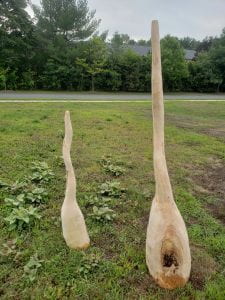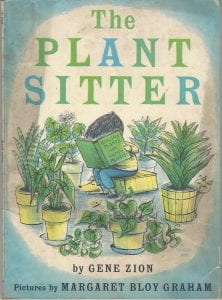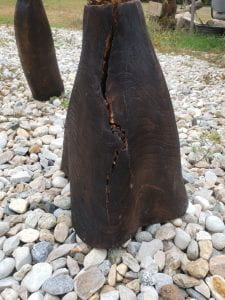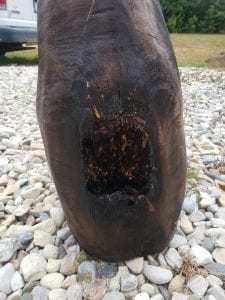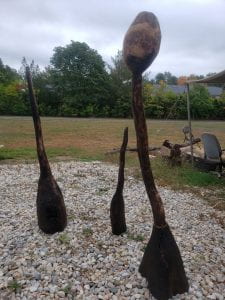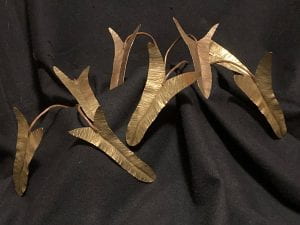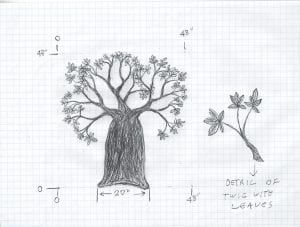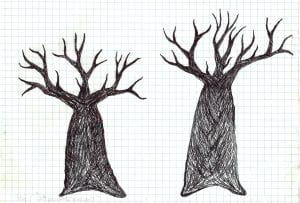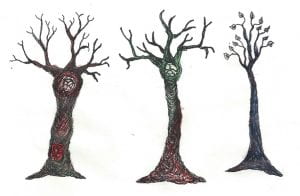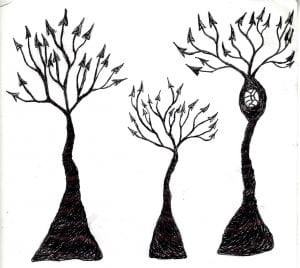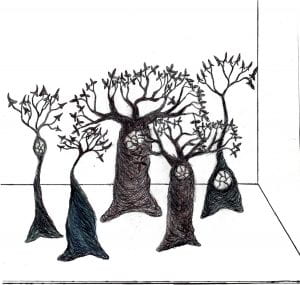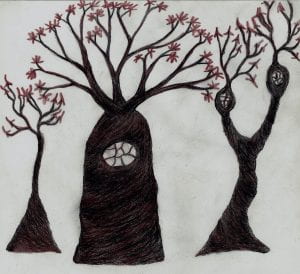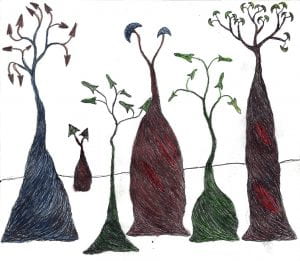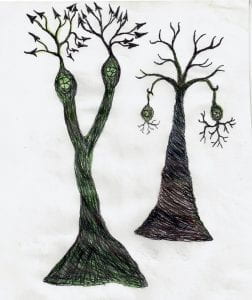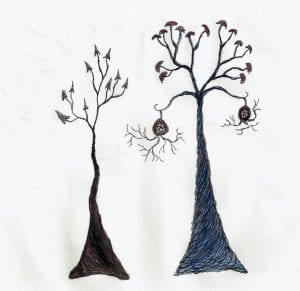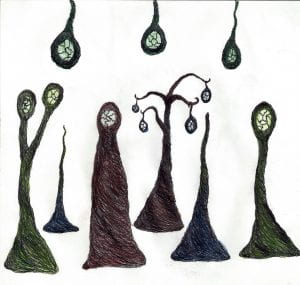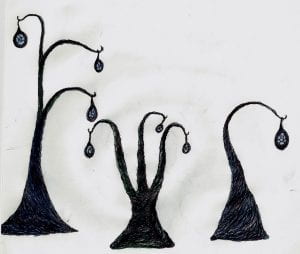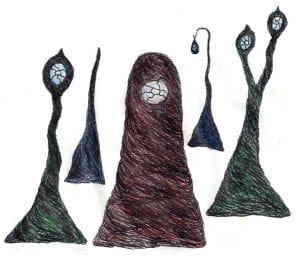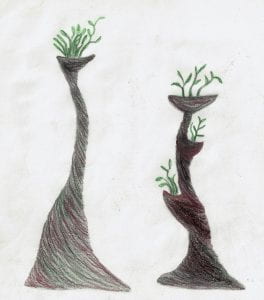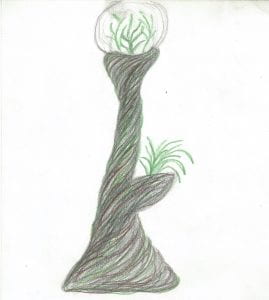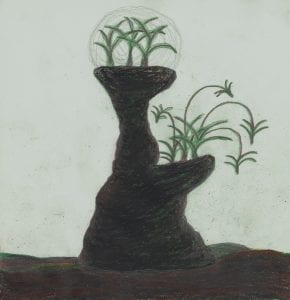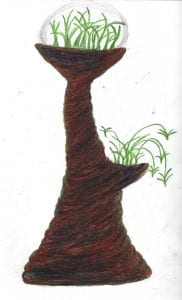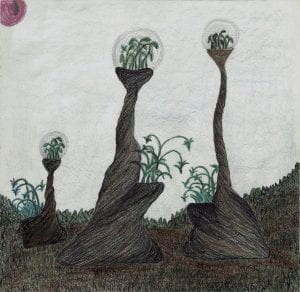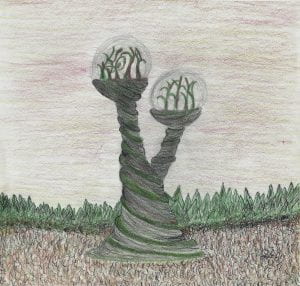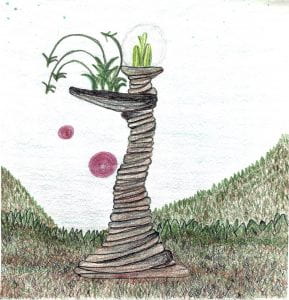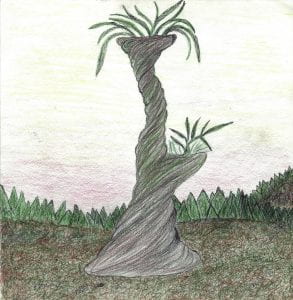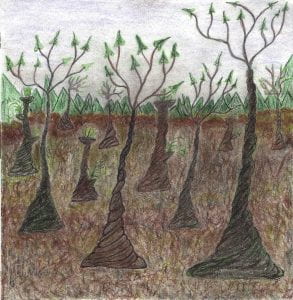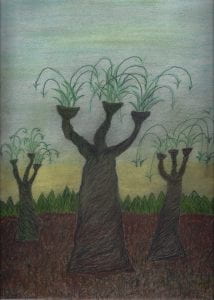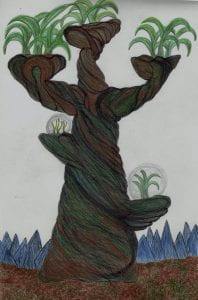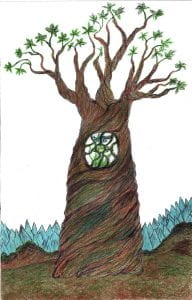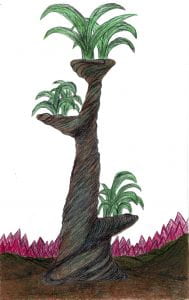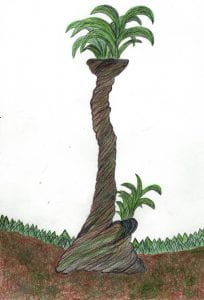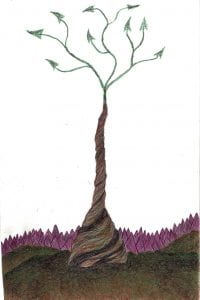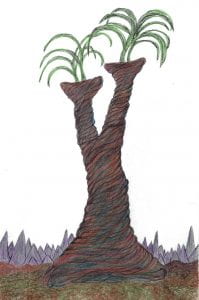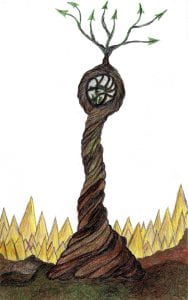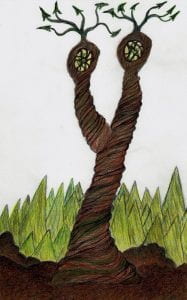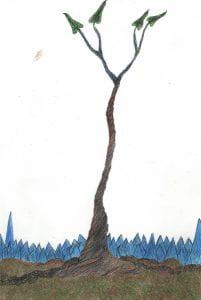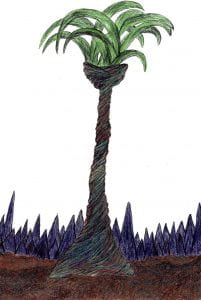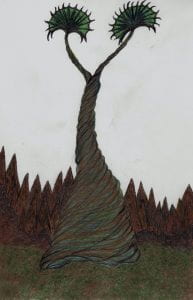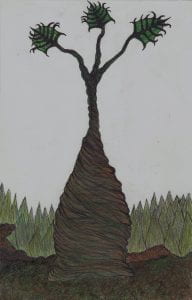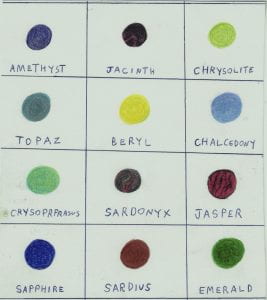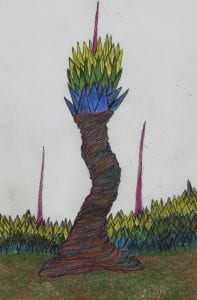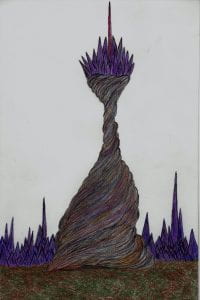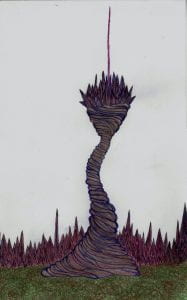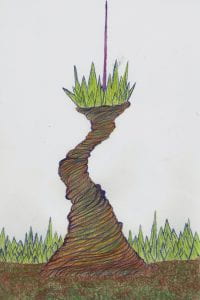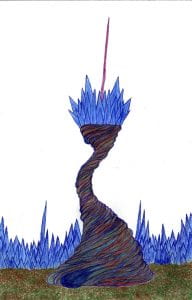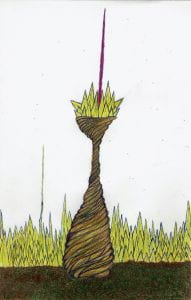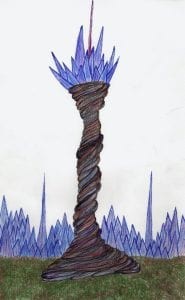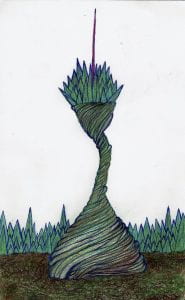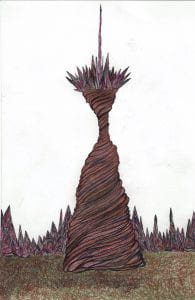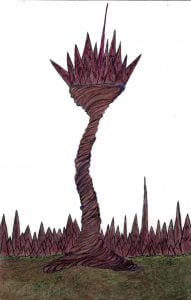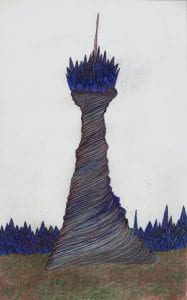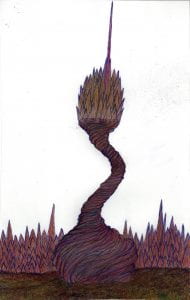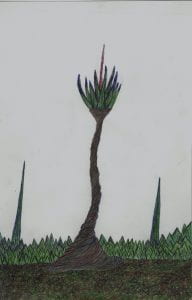I’m continuing work on the Baobab Trees; specifically, the trunks and the branches.
Originally, the Baobab tree I produced in 2019, the trunk was made from a steel frame layered with slats of wood (2″ X 4″ and strapping). My plan is to explore materials starting with smaller scale Baobab trees to perfect the design and then become progressively larger.
I’ve acquired logs of various thicknesses and sizes to experiment with the trunk structures to see what will work best for my vision and esthetics, as well as, durability, practicality holding orbs for terrariums and aquariums, and being transportable.
Originally, I formed and rolled 16-gauge sheet steel for the limbs. Then, I welded the seams together to make it one solid piece. I felt there wasn’t enough gesture of the limbs with a fluidity I was seeking.
For the branches, I’m going to forge pipe using the power hammer in the weld shop, combined with the gas forge to create limbs for the trees as I imagine them. I’m also thinking of combining wood with the steel to form the limbs.
It will be exploratory at the beginning until I reach a decisive path and method. Once I decide upon the materials and processes, then I will have developed a system to follow. From my experience in the past, things will become clearer quickly.
I will start working on my paleo-archaic painting concepts. I’ve begun researching, acquiring a large amount of bog iron ore to use as natural pigment for the paintings. I plan on using crushed coal, crushed steel slag, and crushed soapstone for pigment, in addition to, the acrylic paints. I’m contemplating shaping the canvas to create 3-D reliefs.
I’m envisioning the exhibit being as if one was stepping into an other-worldly environment, outside of our time period. People would move through the exhibit as if walking through a forest, casting shadows upon the hybrid mural reliefs.
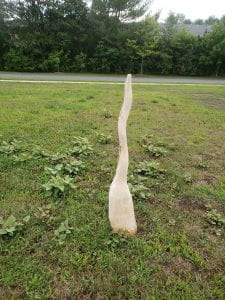 This trunk is 42-inches tall (42″). This was a Maple tree log found at the local Transfer Station. I used a chainsaw to rough our the shapes, and then I used a disc sander attachment on my Angle Grinder to do the final shaping
This trunk is 42-inches tall (42″). This was a Maple tree log found at the local Transfer Station. I used a chainsaw to rough our the shapes, and then I used a disc sander attachment on my Angle Grinder to do the final shaping
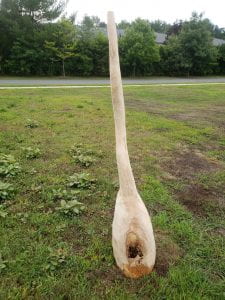 This trunk is 5-feet 2-inches tall (5’2″). This was also a Maple tree log found at our local Transfer Station. Same method as above.
This trunk is 5-feet 2-inches tall (5’2″). This was also a Maple tree log found at our local Transfer Station. Same method as above.
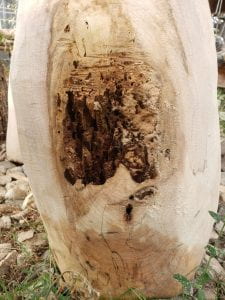 Closeup of knot on large Baobab trunk
Closeup of knot on large Baobab trunk
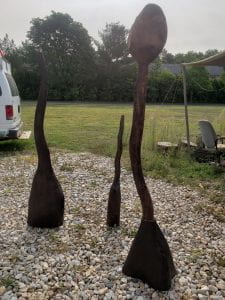 I char-finished each piece with my oxy-acetylene torch using a large rosebud tip, and then with an abrasive pad and the power hose attachment, I washed off the soot on each piece.
I char-finished each piece with my oxy-acetylene torch using a large rosebud tip, and then with an abrasive pad and the power hose attachment, I washed off the soot on each piece.
In relation to my final thesis piece; what was leading up to this body of work of having a garden and bringing it inside, as opposed to having it outside, relates to my childhood. Everyone sees a garden outside but not everybody gets to see that inside. When I was six- to nine-years old, I was walking down 34th Street between 5th and 7th Avenues with my mother, I was looking through the window of a huge atrium of a building. I saw what looked like a grove of trees growing alongside the escalators in a garden setting, which was really fascinating. I remember receiving this children’s book, The Plant Sitter; it’s about a boy whose father was very busy with work, and could not afford the time to take him and his mom on holiday. The boy decided to be a plant sitter; all the people in the neighborhood would bring their plants to his house for the little boy to look after the plants. When his mother went into their house, she saw their home was filled with plants everywhere, even on the floors. She was shocked to see their home invaded by plants. His father came home from work, and he stumbles over a plant on the walkway into their house, and he becomes furious. The boy explains that he’s a plant sitter, and since they were not able to go away for vacation, he decided to take care of the plants for two cents per day per plant. The inside of their home looked like a forest. The next morning, when the family was having breakfast in the kitchen, the kitchen was filled with plants large and small, and the boy thought it was like having a picnic in the woods, but his father was not enjoying it at all. That night in the living room, the father turns on the television, and it was like watching an outdoor movie in the middle of the jungle. His father grumbled and the mother felt the same way. Before bedtime, the boy takes a bath, and it was like swimming in a little lake in the middle of the forest. The little boy fell asleep in his bathtub, enjoying the experience so much. His mother helped him to his bed and tucked him in, telling him he would have to water the plants the next day. That night, the boy dreamed that the plants grew so big and thick that they crowded out the house and the walls of the house fell down, all of the plants held the form of the house. All the people returned home yelling, “Where are my plants? Where are my plants?,” while he’s watering them with the garden hose. He suddenly woke up to his father yelling, “Where are my pants, where are my pants?” The neighbors returned home with their plants well-cared for, and they paid the little boy. The father came home from work and not busy any longer, decided to take his family to the country for a vacation.
I remember going to artist, David Diao’s loft, a floor above ours, and in the middle of his space, he had a forest of trees and plants growing in an island-type setting, which reminded me of the book. At the time, one of the lofts, in our building, was being emptied of its contents, and there were all of these plastic plants and flowers and a huge poster of a stream in the woods in the fall, which I acquired. There was a floor under my bunkbed, and I arranged it like a forest scene installation with all the plastic plants I acquired, with the poster as the backdrop. James Rosenquist was stopping by, since his loft was on the third floor, and I brought him into my room to see what I had done, and when he looked at it, his mouth was hanging wide open, in amazement. That was my first installation piece. By the time I’m 60-years old, I will have actualized the vision of my thesis from my childhood.
These images are updates taken on September 29, 2020
These images were sketches done in pen, and the colors were added with pencil. They began as the Baobab forms, and then, they morphed into biomorphic plant forms. It was an experimentation to see what they would look like without branches. I’m contemplating on the form of the trunk.
These are the next grouping of drawings developing the color and the landscape for the eventual installation. The plants are enclosed in glass orbs on some of them. What I would like to highlight here is the transition of the background landscape of trees becoming crystal formations. In two of the drawings, I experimented with having two red dwarf suns in the Alpha Centauri system. The tree trunk forms appear gestural and anthropomorphic. I tried using oil pastels in a couple of the drawings, which I didn’t like. The pastels made the tree forms appear too flat, and they wouldn’t allow for the layering of color and linear details I needed. With the color pencils, I was able to create a more three dimensional effect.
These twelve drawings form a grouping where I experimented with the crystals in the background representing the twelve gemstones in the foundation of the New Jerusalem, written about in the Book of Revelation Chapter 21, Verses 19 – 20. The number twelve is significant in the Bible referring to the twelve apostles and the twelve tribes of Israel. Each tree form is an individual part of an installation. These are advanced drawings. I played with the branch and leaf representations, with some of them having multiple plants growing from the trunks. Some of the plant forms had shelves, and they were protruding from the trunk. At the top of the trunk, there would be a plant growing out of a bowl-like form. There are three tree forms with orbs within the trunks holding either aquariums or terrariums.
These drawings became the next phase incorporating the crystals in lieu of the plants. It’s a more literal representation of the twelve gemstones of the New Jerusalem and the twelve apostles. The thirteenth drawing with the multi-colored crystals represents the Church and Paul, the Apostle to the gentiles (viewed here as the first drawing right of the crystal color chart). In each of these drawings, there’s a red beam projecting upward from the crystals representing the blood or life of the crystals and the tree forms. It is unknown, according to the Bible, which stone is assigned to each apostle. Nevertheless, each crystal is connected to an apostle. “And the wall of the city had twelve foundations, and on them were the twelve names of the twelve apostles of the Lamb” (Revelation 21:14).

